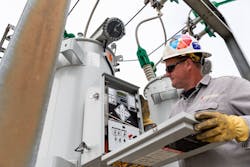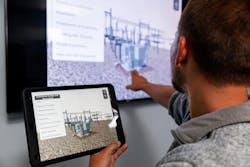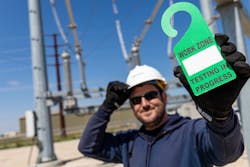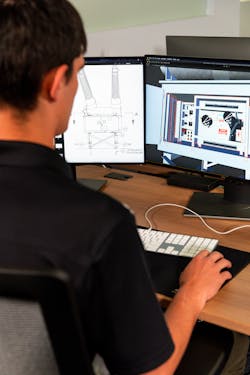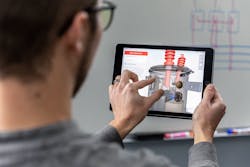Through a combination of animations, augmented reality (AR) and 3D modeling, apprentices can view components from any angle, visualize complex tasks and better understand how equipment works.
The curriculum also incorporates video demonstrations from other technicians and electricians across the company to supplement the apprenticeship content. While much of the apprenticeship is hands-on learning, the new digital curriculum can help bridge the gap when apprentices do not have the opportunity to work on those devices in the classroom or field.
Transitioning to Digital
Prior to implementing the digital curriculum and construction of MidAmerican’s Training Center for Excellence in Des Moines, Iowa, continuing education for the journeymen was extremely limited, says Chelsea McCracken, vice president of safety, training and development at MidAmerican Energy. Supplemental training was limited to what could physically be lined up and worked on at any given place or time. Even then, the apprentice would have to travel to that location to experience what was being presented. MidAmerican Energy developed mock units for each work location and reviewed and shared text-heavy lessons-learned documents among groups.
Delivered via tablets assigned to each new worker, however, the new digital curriculum, developed in partnership with Index AR Solutions, will continue to be available for reference even after they top out as journeymen and help the next apprentices. With the new digital curriculum, MidAmerican’s own personnel can fully capture these events and training opportunities on video and incorporate them into the appropriate section of the eBooks. This approach enables anyone to consume training content in a consistent manner, anywhere at any time.
Training Users
When rolling out the digital curriculum, it was essential to secure buy-in and engagement from everyone in the training process, McCracken says. This includes assigning a dedicated project leader, identifying subject matter experts early in the curriculum development process and helping represented workers understand their stake in the outcome. It is important for apprenticeship trainers and workers to understand how the material will be created and used, as their involvement is key to project success, she added.
After training is complete, workers can continue using their training tablets whenever they need to see an example of a device configuration or when they need refresher on a complicated procedure. Standards and safety rules are available and searchable on the devices, making them a convenient reference tool.
Investing in Mobile Technology
At MidAmerican Energy, substation technicians and electricians have a company-issued mobile phone and a company-issued laptop to perform their work-related tasks. As digital training content was being developed and after it was issued as final, company-issued tablets were used as the primary delivery mechanism. All final eBooks and mobile app visualizations are available on these managed company devices at each department location across the state.
On their first day, new substation technician and electrician apprentices receive a company-supplied tablet preloaded with the digital training material and supporting items such as standard manuals and safety rule books. Apprentices keep their tablets and use them as a field reference after training is completed. Electronic bookmarks and notes stay with each apprentice.
In addition, apprentices can access training eBooks on the company-issued mobile phones. MidAmerican also assigns technicians rugged devices for field work.
Training on the Go
MidAmerican Energy, which has 35 substation technicians, shifted from a four-year Substation Technician and Electrician apprenticeship to a three-year program.
“Condensing the apprenticeship into three years makes it essential that the training materials are high quality and accessible to technicians/electricians no matter where they are,” McCracken says.
The digital curriculum helps to train substation technician and electrician apprentices on the work they do in the field, as well as the laptops and other tools they rely on each day. This includes relay testing and troubleshooting, proper use of physical tools like multimeters and relay test sets, as well as “soft” tools like Human Performance Improvement (HPI) tools, safety rules and common practices such as setting up work boundaries.
The eBooks and apps comprising the digital curriculum provide apprentices a way to learn on their own using a familiar platform and a format that works best for them. The curriculum delivers information in a multi-modal fashion, using rich text, video and augmented visualizations that supplement the apprenticeship.
Advancing in the Apprenticeship
Once the substation technician and electrician apprenticeship is underway, every six-month phase includes a 40-hour week at MidAmerican’s Training Center for Excellence. Peer evaluations are given each month and reviewed by the Local Apprenticeship Committee via conference call. As an apprentice progresses through the training phases, they will use the tablet-based training elements to supplement and reinforce concepts learned in the Training Center for Excellence and better understand related material.
A Line Mechanic digital curriculum is currently in development. Once complete, line mechanic apprentices will use the curriculum in conjunction with NJATC materials for an immersive learning experience. Visualizations and training videos featuring subject matter experts complement written eBook instructions to show apprentices how to virtually wire transformers, understand how various types of equipment operate and more.
Taking a Hybrid Approach
The benefits of using a digital curriculum, which can help teams seamlessly transition from in-person training to virtual training, came into focus during the pandemic. MidAmerican apprenticeships that had deployed a digital curriculum were able to continue during work modifications necessary to respond to COVID-19 guidance from state and federal agencies with minimal impact to training schedules.
The recent global pandemic disrupted many business operations, particularly those requiring in-person gatherings. A mobile training platform can help minimize the impact of facility closures, prevent apprentices from falling behind and help ensure that staffing levels remain sufficient.
Hands-on and classroom training will continue to be a critically important component of MidAmerican apprenticeships, including those related to electric operations. The digital curriculum is a valuable supplement that helps reinforce concepts and procedures learned in the classroom using a device that can be taken anywhere.
Amy Fischbach ([email protected]) is the Field Editor for T&D World magazine.
About the Author
Amy Fischbach
Electric Utilities Operations
Amy Fischbach is the Field Editor for T&D World magazine and manages the Electric Utility Operations section. She is the host of the Line Life Podcast, which celebrates the grit, courage and inspirational teamwork of the line trade. She also works on the annual Lineworker Supplement and the Vegetation Management Supplement as well as the Lineman Life and Lineman's Rodeo News enewsletters. Amy also covers events such as the Trees & Utilities conference and the International Lineman's Rodeo. She is the past president of the ASBPE Educational Foundation and ASBPE and earned her bachelor's and master's degrees in journalism from Kansas State University. She can be reached at [email protected].
